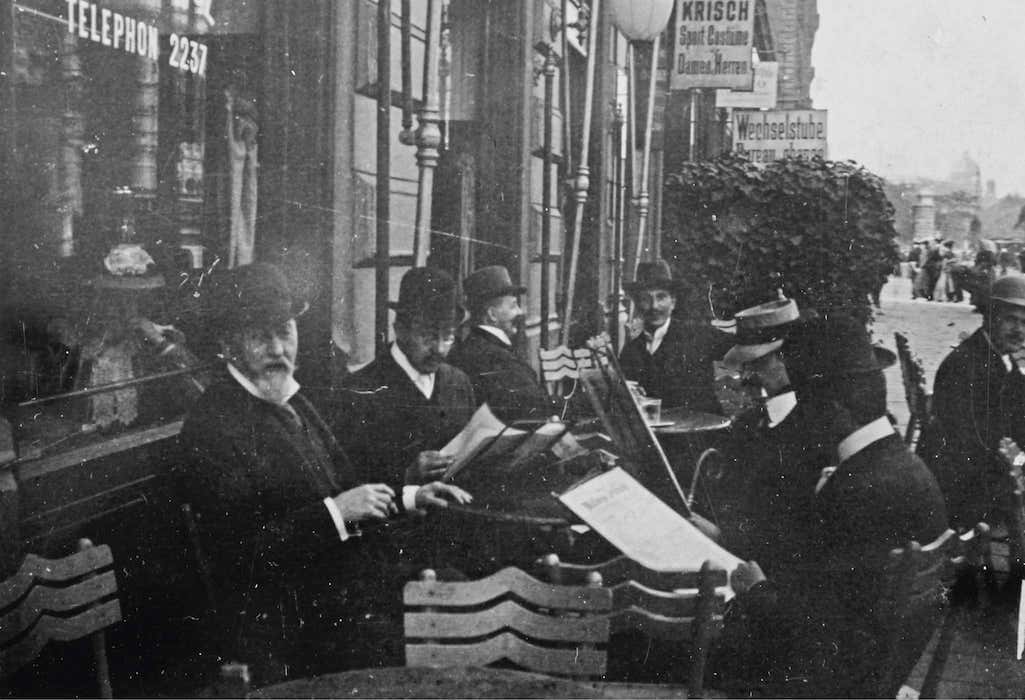
OTTO WAGNER (first on the left) with JOSEF HOFFMANN (second on the left) and KOLOMAN MOSER (third on the left) at Café Bristol on Kärntner Ring ca. 1905 © IMAGNO/Collection Hubmann
"It must have been very interesting in Vienna back then ...”
In 2018 the Austrian capital is celebrating Viennese Modernism. Four of the era’s chief protagonists died 100 years earlier: Gustav Klimt, Egon Schiele, Otto Wagner and Koloman Moser, all of whom significantly shaped turn-of-the-century Vienna. A review.
In 1918 nothing was like it had been before
The world had changed. The futile First World War claimed millions of lives and led to a shift in the balance of power in Europe. The monarchies in Germany and Austria fell. Overnight, emperors, kings and princes were “washed up like the flotsam and jetsam of a suddenly sunken world” 1 .Republics emerged: the First Republic in Austria and the Weimar Republic in Germany. And the world-famous Viennese Modernism experienced a watershed moment. Not only due to the deaths in 1918 of Klimt, Schiele, Wagner and Moser, four of the leading lights of what turned out to be the most important era in Austrian cultural, artistic and social history. But also because the spirit of new beginnings at the end of the long nineteenth century fell victim to the nationalistic, omnipotent fantasies of a handful of megalomaniac warmongers.
More than two million inhabitants
Just a few years earlier, everything was right with the world: “It must have been very interesting in Vienna back then,” wrote the author Hermann Bahr in his book Expressionismus, which first appeared in 1916. And so it was: In the second half of the 19th century Vienna went down a special route all of its own, transforming itself into the intellectual andartistic center of the world. But how? The revolutions of 1848 left Vienna relatively unscathed from a democratic point of view. Led by the conservative emperor Franz Joseph, the Habsburgs were firmly in control. The nobility and the clergy held the reins. By 1910 immigrants had flocked to Vienna from all over the Dual Monarchy, forming a multinational, multilingual and multicultural city with a population of more than two million. The last major military campaign came in 1866 (which, like so many before, the Habsburgs lost): the Battle of Königgrätz. From that point on, the Habsburgs “only” held sway over their own Dual Monarchy. A period of peace followed. The 1860s saw full civil rights conferred on the Jewish population. Like the nobility and clergy, they were able to acquire plots of land to build on and would go on to become influential patrons of the arts. Following the 1867 constitutional reforms, the liberals found themselves at the political helm. The stock exchange crash of 9 May 1873 brought their first major setback. And in 1879 they were defeated in parliamentary elections. The conservatives, led by Count Eduard Taaffe, stepped into the breech.
- 1Lothar Machtan: Die Abdankung. Wie Deutschlands gekrönte Häupter aus der Geschichte fielen (dtv Verlagsgesellschaft, April 22, 2016)
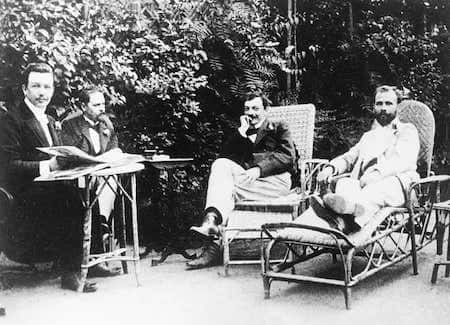
Joseph Maria Olbrich (left), artists Franz Hohenberger, Koloman Moser and Gustav Klimt (right) in Fritz Waerndorfer’s garden in Vienna, 1899 © IMAGNO/ÖNB

Director Franz Zavrel, Koloman Moser, Hermann Bahr and Peter Altenberg (l-r) on the beach in Venice, 1913 © IMAGNO/Austrian Theater Museum
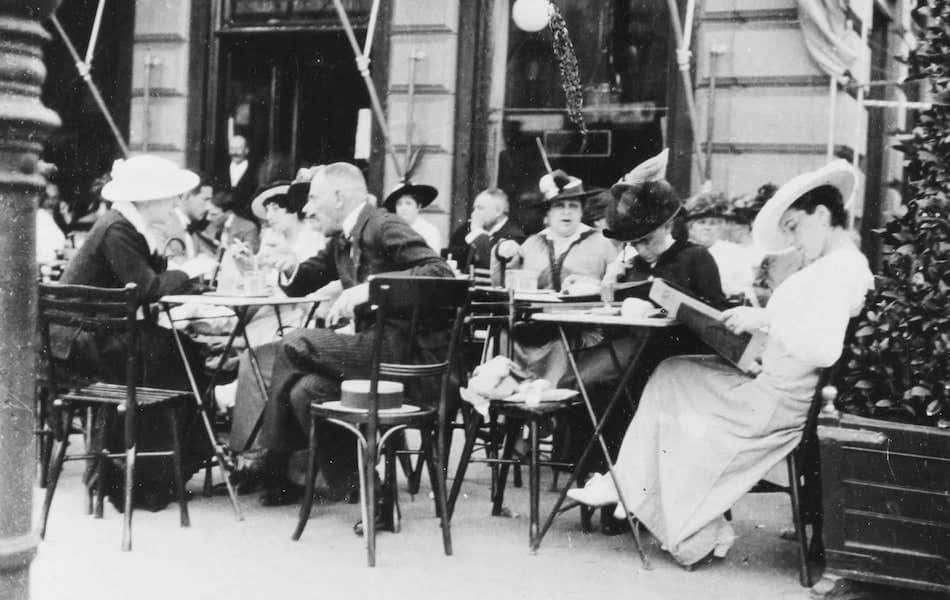
© IMAGNO/Austrian Archives
Café on the Ringstrasse
with outdoor seating, 1915
Meeting at the coffeehouse
This phase of social and political upheaval provided a fertile breeding ground for novel approaches. Anyone who found themselves outside the upper echelons of society sought an alternative to social betterment in art and culture. People began to focus on the finer things in life, while questioning the political status quo. Outwardly cozy, Vienna was the perfect place for this: not too big, but not too provincial either. The neuroscientist and Nobel Prize winner Eric Kandel, who emigrated from Vienna to the USA with his parents in 1939, would later make the following apposite observation: “Indeed Viennese life at the turn of the century provided opportunities in salons and coffeehouses for scientists, writers and artists to come together in an atmosphere that was at once inspiring, optimistic, and politically engaged.” 2
Carl E. Schorske, the great historian who passed away in 2015, wrote a touchstone volume for turn-of-the-century Vienna in 1980 with his book Fin-De-Siècle Vienna: Politics and Culture, and was fully aware of the special role played by the capital: “In London, Paris, or Berlin the intellectuals in the various branches of high culture, whether academic or aesthetic, journalistic or literary, political or intellectual, scarcely knew each other.
They lived in comparatively segregated professional communities. In Vienna, by contrast, until about 1900, the cohesiveness of the whole elite was strong. The salon and the café retained their vitality as institutions where intellectuals of different kinds shared ideas and values with each other and still mingled with a business and professional elite proud of its general education and artistic culture.” Boundaries between science and the arts blurred. People argued and debated, wrote and published, researched and experimented across the board. Intellectuals, artists, architects, writers, physicians, musicians, designers and many other individuals would meet in various constellations at the city’s salons and coffeehouses.
- 2Eric Kandel: The Age of Insight: The Quest to Understand the Unconscious in Art, Mind, and Brain, from Vienna 1900 to the Present (Random House, 2012)
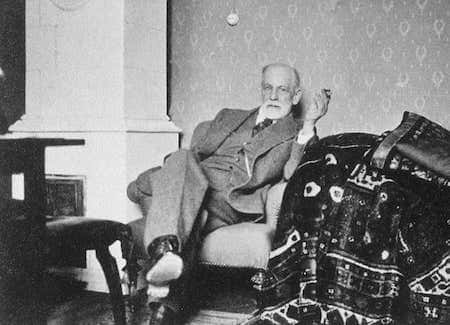
SIGMUND FREUD at his summer house, 1932
© IMAGNO/Sigmund Freud Foundation
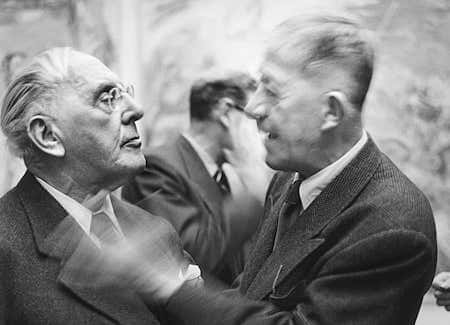
JOSEF HOFFMANN (left), and OSKAR KOKOSCHKA, Secession, 1955
© IMAGNO/Franz Hubman
Werewolf at a ladies’ circle
It was in this creative center that Gustav Klimt, Egon Schiele, Otto Wagner and Koloman Moser worked and left behind countless traces in Vienna that endure to this day: Wagner (1841-1918) as an architect and urban planner; Klimt (1862-1918) as the inventor of Viennese Art Nouveau, or Jugendstil, and portraitist to the rich and famous; Schiele (1890-1918) as an expressionist enfant terrible; and Koloman Moser (1868-1918) as Wiener Werkstätte co-founder and pioneering graphic and product designer. At their side, numerous other artists, scientists, intellectuals and – for the first time – lots of women shaped the city. Prominent names include Gustav Mahler, who whipped the Vienna State Opera into shape. And Arnold Schönberg, whose 12-tone works revolutionized the world of music. Sigmund Freud found Vienna to be the perfect environment for working on his interpretation of dreams. Arthur Schnitzler’s literary landscapes of the soul had their roots in Freud’s insights. “Internal worlds became reality.” 3 After all, “art nouveau has plumbed deeper psychological depths in Vienna than anywhere else” 4 . Announcing one’s suicide was quite the done thing, but seldom followed through on.
Announcing one’s suicide was quite the done thing, but seldom followed through on. And while sexuality was not yet up for public discussion, matters of the flesh found their way onto the artists’ canvasses. “Art in Vienna had to be honest, it had to open people’s hearts – and part their thighs,” said the art historian Kia Vahland 5 .Oskar Kokoschka is said to have “burst onto the Viennese art scene like a werewolf at a ladies’ circle” 6 . When he designed the Secession building (“To every age its art, to art its freedom”), Joseph Maria Olbrich created the most contemporary exhibition space of its age, complete with a striking gold cupola. Adolf Loos’ pared-down designs provided an architectural counter- point to the ornamentation found in Austrian Art Nouveau. Josef Hoffmann and Josef Frank took the first steps towards developing the social housing that continues to play such an important role in Vienna to this day. Wiener Werkstätte was dedicated to the notion of the Gesamtkunstwerk, or total work of art, and devoted to making a timeless style part of everyday life. And Ludwig Wittgenstein, who played a key role in planning a building in Vienna that would bear his name, published his Tractatus Logico-Philosophicus, which propagated the use of a clear language in philosophy.
Berta Zuckerkandl, Fanny von Arnstein, Eleonora Princess Fugger and Sophie von Todesco were just some of the high-profile women who made a significant contribution to Vienna’s culture of political and social discourse with their salons. Klimt’s lifelong companion, Emilie Flöge, was a fashion designer and did much to liberate the city’s women from the constraints of the corset. And then there was Alma Mahler-Werfel: for many she was a femme fatale and more than a mere muse, often ending up as lover to the men she inspired. The fact that she herself was a composer is largely forgotten today.
- 3Florian Illies: 1913. The Year Before the Storm (Fischer Taschenbuch, August 21, 2014)
- 4Art historian Kia Vahland in Geo Epoche, 14th edition. Die Geschichte der Kunst: Jugendstil und Art Déco. Die Ästhetik des Alltags 1890-1940 (Gruner + Jahr 2016)
- 5Ibid.
- 6Eric Kandel: The Age of Insight: The Quest to Understand the Unconscious in Art, Mind, and Brain, from Vienna 1900 to the Present (Random House, 2012)
Demolition work on the old city fortifications in the foreground and start of construction work on Palais Schey. The completed Heinrichshof, which was all but destroyed in the Second World War, can be seen in the background, 1863
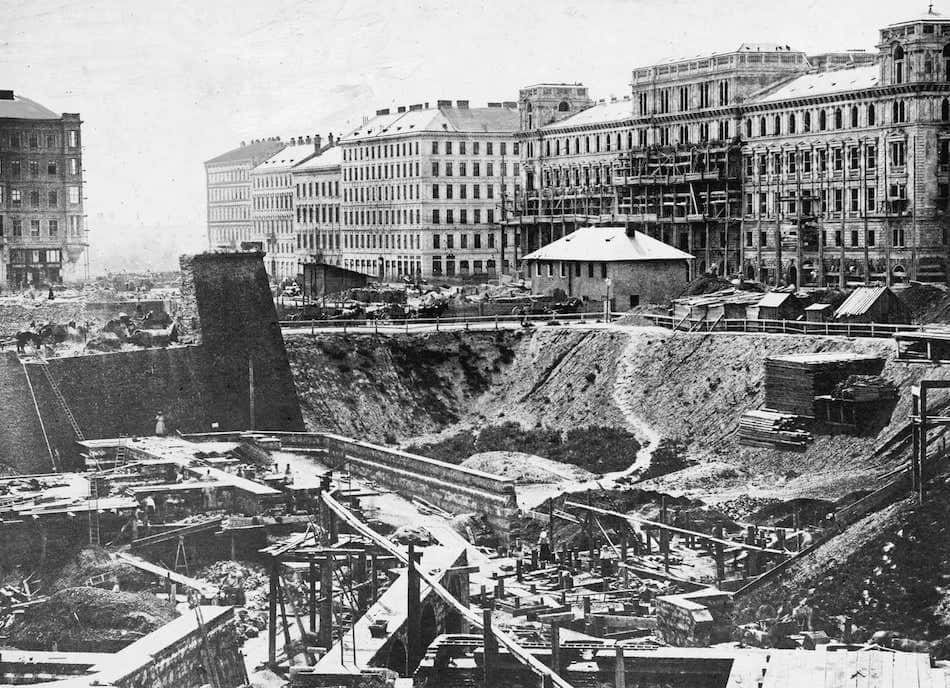
© IMAGNO/ÖNB
Birth of the Ringstrasse
Karl Kraus, the famous publicist and publisher of the journal Die Fackel, supported his colleagues such as Peter Altenberg and was not averse to picking public quarrels with other great thinkers such as Freud, Schnitzler and Bahr. And while others argued, some people channeled their energies into the finer things in life – such as Eduard Josef Wimmer-Wisgrill, who founded Wiener Werkstätte’s fashion department in 1907 and developed Wiener Mode fashion. During this period Vienna’s showpiece Ringstrasse boulevard was still under construction. Although it was commissioned in 1857, monumental buildings, city palaces belonging to the nobility and mansion houses owned by members of the burgeoning upper middle classes continued to go up on the 5.3 kilometer route until well into the twentieth century. Modern materials were used; as were countless immigrants from neighboring Bohemia and Moravia. Known as “Ziegelbehm”, these poor souls endured wretched working conditions in the city’s brickworks, churning out building materials for the capital’s elite.
"In 1913, a year that oscillated between beauty and abyss on the cusp of the First World War, Vienna abounded “with strength” 7 . “It had become a world city and this could be seen and felt all over the world – everywhere except in Vienna itself, where, through sheer joy in self-destruction, people hadn’t realized that they had unexpectedly come to the apex of the movement which called itself Modernism. Because selfdoubt and self-destruction had become a central component of the new way of thinking, and what Kafka called the ‘Nervous Era’ had dawned. And in Vienna nerves – virtually, metaphorically, artistically and psychologically – were laid bare like nowhere else. Berlin, Paris, Munich, Vienna. These were the four frontier towns of modernism in 1913.” 8
- 7Illies: 1913. The Year Before the Storm
- 8Ibid.
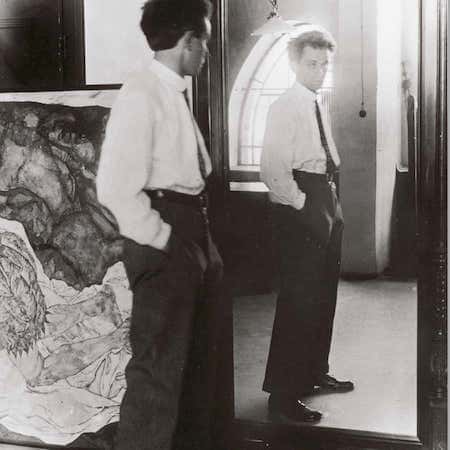
EGON SCHIELE in front of the mirror in his workshop at Hietzinger Haupstrasse 101. His painting "DEATH AND GIRL" can be seen in the background (photograph by Johannes Fischer), 1915
© IMAGNO/Austrian Archives
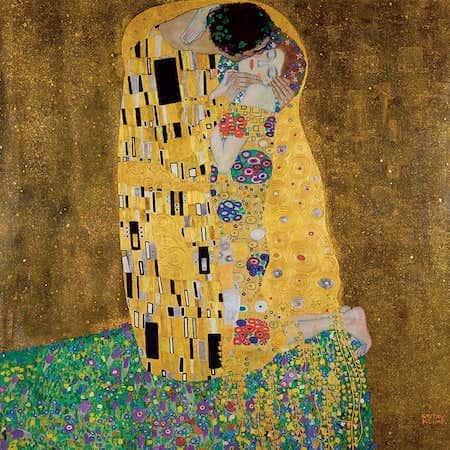
GUSTAV KLIMTS masterpiece "THE KISS", 1908/09 © Belvedere, Vienna
„Dream and Reality“
And today? The two world wars and their legacy caused Viennese Modernism to slip into obscurity. Until the subject suddenly re-entered the collective memory in 1985. An exhibition entitled Dream and Reality hosted by the Wien Museum revisited the period between 1870 and 1930, bringing it and all of its leading lights back to life. More than 600,000 people flocked to the Künstlerhaus for a taste of Klimt, Schiele, Wagner, Moser et al. All of a sudden, interest in this artistic and cultural era was greater than it had ever been. And this interest will remain unbroken, beyond 2018. Because Vienna is still a highly interesting place today.